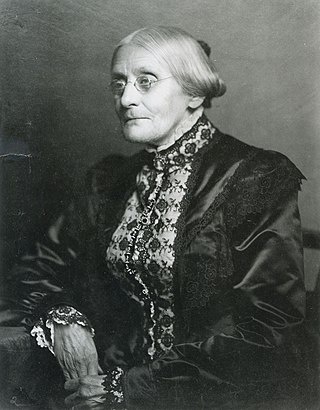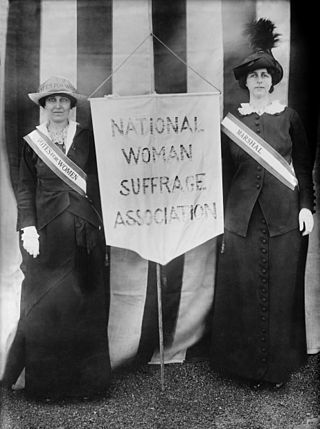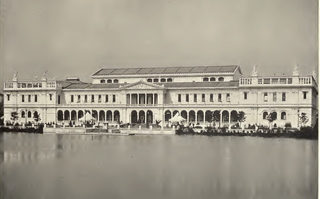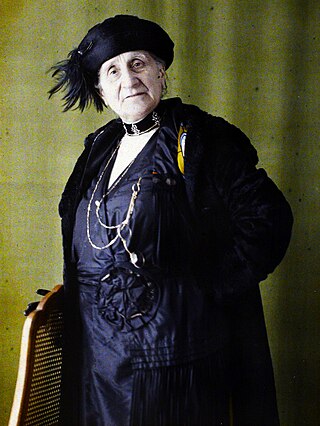
Susan B. Anthony was an American social reformer and women's rights activist who played a pivotal role in the women's suffrage movement. Born into a Quaker family committed to social equality, she collected anti-slavery petitions at the age of 17. In 1856, she became the New York state agent for the American Anti-Slavery Society.

The National Woman Suffrage Association (NWSA) was formed on May 15, 1869, to work for women's suffrage in the United States. Its main leaders were Susan B. Anthony and Elizabeth Cady Stanton. It was created after the women's rights movement split over the proposed Fifteenth Amendment to the U. S. Constitution, which would in effect extend voting rights to black men. One wing of the movement supported the amendment while the other, the wing that formed the NWSA, opposed it, insisting that voting rights be extended to all women and all African Americans at the same time.

Carrie Chapman Catt was an American women's suffrage leader who campaigned for the Nineteenth Amendment to the United States Constitution, which gave U.S. women the right to vote in 1920. Catt served as president of the National American Woman Suffrage Association from 1900 to 1904 and 1915 to 1920. She founded the League of Women Voters in 1920 and the International Woman Suffrage Alliance in 1904, which was later named International Alliance of Women. She "led an army of voteless women in 1919 to pressure Congress to pass the constitutional amendment giving them the right to vote and convinced state legislatures to ratify it in 1920". She "was one of the best-known women in the United States in the first half of the twentieth century and was on all lists of famous American women."

Ishbel Maria Hamilton-Gordon, Marchioness of Aberdeen and Temair, was a British writer, philanthropist, and an advocate of women's interests. As the wife of John Hamilton-Gordon, 1st Marquess of Aberdeen and Temair, she was viceregal consort of Canada from 1893 to 1898 and of Ireland from 1906 to 1915.
The Sophia Smith Collection at Smith College is an internationally recognized repository of manuscripts, photographs, periodicals and other primary sources in women's history.

The International Alliance of Women is an international non-governmental organization that works to promote women's rights and gender equality. It was historically the main international organization that campaigned for women's suffrage. IAW stands for an inclusive, intersectional and progressive liberal feminism on the basis of human rights and liberal democracy, and has a liberal internationalist outlook. IAW's principles state that all genders are "born equally free [and are] equally entitled to the free exercise of their individual rights and liberty," that "women's rights are human rights" and that "human rights are universal, indivisible and interrelated." In 1904 the Alliance adopted gold as its color, the color associated with the women's suffrage movement in the United States since 1867 and the oldest symbol of women's rights; through the Alliance's influence gold and white became the principal colors of the mainstream international women's suffrage movement.

May Wright Sewall was an American reformer, who was known for her service to the causes of education, women's rights, and world peace. She was born in Greenfield, Milwaukee County, Wisconsin. Sewall served as chairman of the National Woman Suffrage Association's executive committee from 1882 to 1890, and was the organization's first recording secretary. She also served as president of the National Council of Women of the United States from 1897 to 1899, and president of the International Council of Women from 1899 to 1904. In addition, she helped organize the General Federation of Women's Clubs, and served as its first vice-president. Sewall was also an organizer of the World's Congress of Representative Women, which was held in conjunction with the World's Columbian Exposition in Chicago in 1893. U.S. President William McKinley appointed her as a U.S. representative of women to the Exposition Universelle (1900) in Paris.
The National Council of Women of Canada is a Canadian advocacy organization based in Ottawa, Ontario, aimed at improving conditions for women, families, and communities. A federation of nationally-organized societies of men and women and local and provincial councils of women, it is the Canadian member of the International Council of Women (ICW). The Council has concerned itself in areas including women's suffrage, immigration, health care, education, mass media, the environment, and many others. Formed on October 27, 1893, in Toronto, Ontario, it is one of the oldest advocacy organizations in the country. Lady Aberdeen was elected the first president of the National Council of Women of Canada in 1893. Prominent Council leaders included Lady Gzowski, Dr. Augusta Stowe-Gullen, and Adelaide Hoodless.

The World's Congress of Representative Women was a week-long convention for the voicing of women's concerns, held within the World's Congress Auxiliary Building in conjunction with the World's Columbian Exposition. At 81 meetings, organized by women from each of the United States, 150,000 people came to the World's Congress Auxiliary Building and listened to speeches given by almost 500 women from 27 countries.

The International Congress of Women was created so that groups of existing women's suffrage movements could come together with other women's groups around the world. It served as a way for women organizations across the nation to establish formal means of communication and to provide more opportunities for women to ask the big questions relating to feminism at the time. The congress has been utilized by a number of feminist and pacifist events since 1878. A few groups that participated in the early conferences were The International Council of Women, The International Alliance of Women and The Women's International League for Peace and Freedom.

Jessie Chrystal Macmillan was a suffragist, peace activist, barrister, feminist and the first female science graduate from the University of Edinburgh as well as that institution's first female honours graduate in mathematics. She was an activist for women's right to vote, and for other women's causes. She was the second woman to plead a case before the House of Lords, and was one of the founders of the Women's International League for Peace and Freedom.

Jeni Bojilova-Pateva, also transliterated as Zheni Bozhilova-Pateva, was a Bulgarian teacher, writer, women's rights activist, and suffragist, who became involved in the pacifist movement. After graduating with teaching credentials in 1893, she began her profession, but was barred from teaching when a law was passed in 1898 that limited the rights of married women. She turned to activism and journalism, becoming involved in the international women's movement that year. A highly prominent feminist, she was one of the founders of the Bulgarian Women's Union in 1901. During 1905 in Burgas, she founded "Self-Awareness", a feminist group, and served as its chair for 25 years. As editor of the Women's Voice she published articles on developments in the women's movement in Bulgaria and abroad, as well as about issues affecting women. Throughout her career, she published over 500 articles and books.

Elsie Hill was an American suffragist, as were her sisters Clara and Helena Hill.

Ghénia Avril de Sainte-Croix was a French author, journalist, feminist and pacifist. For many years she led the French branch of the International Abolitionist Federation, which sought to abolish state regulation of prostitution and fought trafficking in women. She advised the French government and the League of Nations on women's issues. She was vice-president of the International Council of Women from 1920 and President of the National Council of French Women from 1922 to 1932.

The National Council of French Women is a society formed in 1901 to promote women's rights. The first members were mainly prosperous women who believed in using non-violent means to obtain rights by presenting the justice of the cause. Issues in the first half century included the right to vote, legal equality between husband and wife, paternal child support, social support for children, equal employment opportunity, equal pay for equal work and acquisition of citizenship on marriage. The National Council of French Women is affiliated with the International Council of Women (ICW). Now the oldest of French feminist organizations, it continues to work for causes related to the rights of women.
First Conference of the International Woman Suffrage Alliance was held in 1902 in Washington D.C. to consider the feasibility of organizing an International Woman Suffrage Association.

The Seventh Conference of the International Woman Suffrage Alliance met in Budapest, Hungary, 15–21 June 1913. As had been the case with all the preceding International Woman Suffrage Alliance conferences, the location had been chosen to reflect the status of woman suffrage: a place where the prospects seemed favorable and liable to influence public sentiment by demonstrating that it was now a global movement. When it had been announced at the sixth congress that the next one would be held in the capital of Hungary, it was felt that the location seemed very remote, and there were concerns that Hungary did not have representative government. In fact, it proved to be one of the largest and most important conventions. Furthermore, the delegates stopped en route for mass meetings and public banquets in Berlin, Dresden, Prague and Vienna, spreading its influence ever further afield.
The Eighth Conference of the International Woman Suffrage Alliance occurred June 6–12, 1920, in Geneva, Switzerland.

The Glasgow and West of Scotland Association for Women’s Suffrage was an organisation involved in campaigning for women’s suffrage, based in Glasgow, with members from all over the west of Scotland.

Irma Szirmai was a Hungarian pacifist and women's rights activist. One of the founding members of the Feministák Egyesülete, she led its Mother and Child Protection Committee from 1907. She served on the press committee from 1906 to 1913 and was the chair of the interpreters organized to facilitate the Seventh Conference of the International Woman Suffrage Alliance (IWSA), held in Budapest in 1913. She also worked as a deputy for the Board of Wards of the state and visited the orphanage and maternity hospital to assist patients and help them with needed services. A committed pacifist, she joined the Women's International League for Peace and Freedom (WILPF) when the organization was formed in 1915. In addition to her work in Hungary, Szirmai attended numerous international congresses of the IWSA and WILPF and served on international committees dealing with women's nationality and unmarried mothers. From 1925, she co-chaired the Feministák Egyesülete but resigned in 1927 when her daughter died. She returned to co-chair the organization in the 1930s. The organization was banned during World War II but was revived by Szirmai in 1946. It was forced by the government to dissolve again in 1949, but continued to operate clandestinely with Szirmai at the helm until her death in 1958.
















